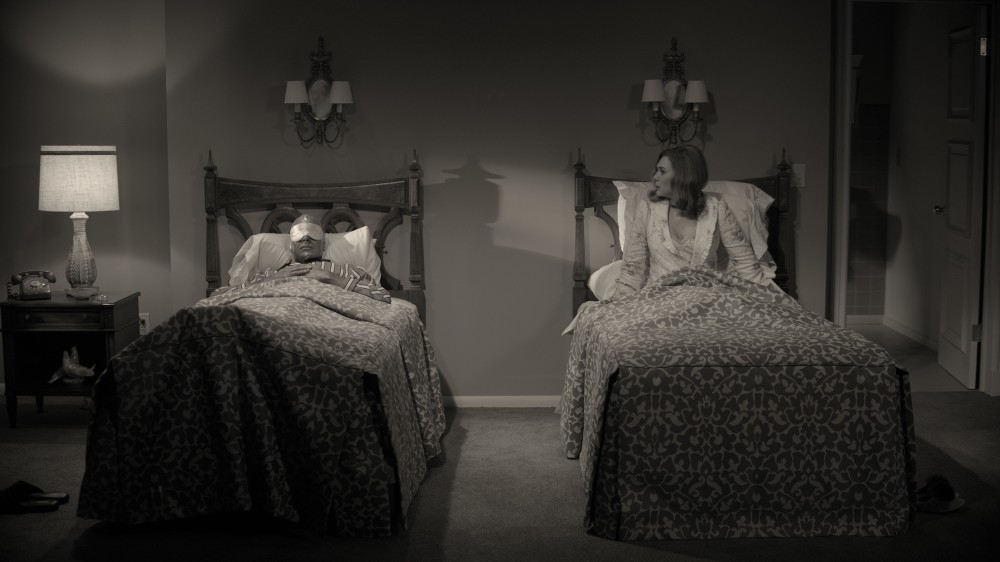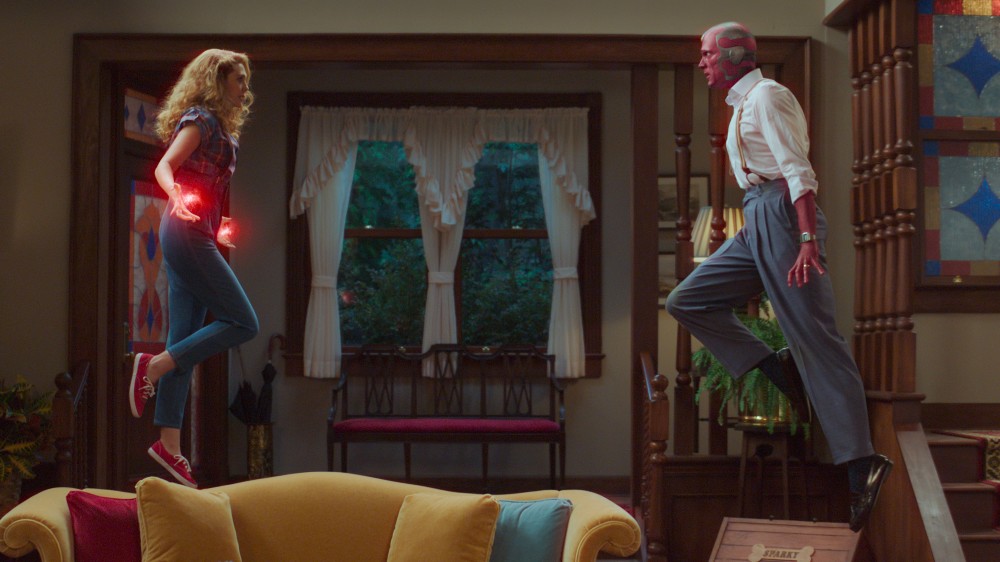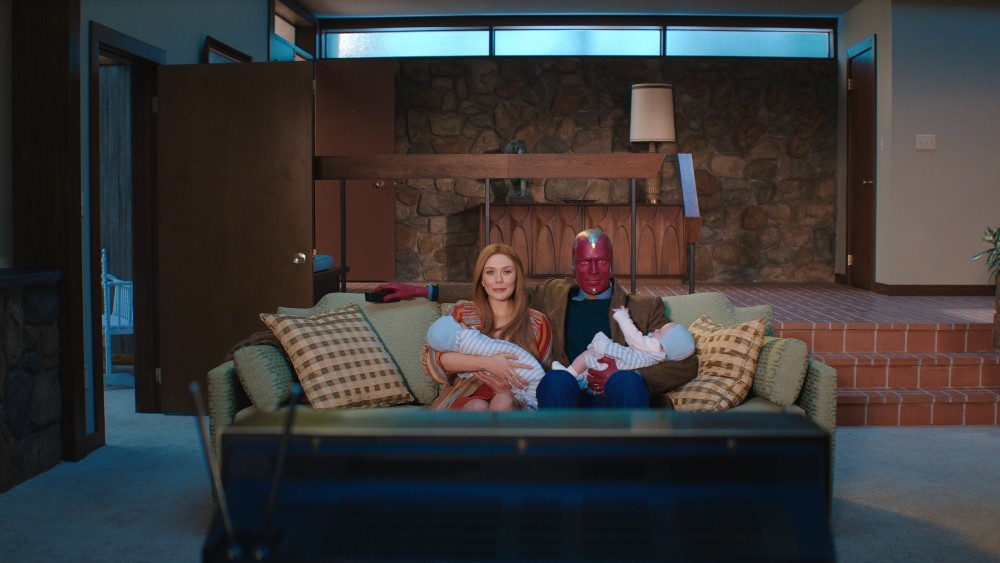
Production Designer Mark Worthington has been nominated for eight Primetime Emmys, and if you look at his amazing work on television over the past few decades, it shouldn’t be much of a surprise why that is.
Worthington’s work in television began as Production Designer for the pilot episode of J.J. Abrams’ Lost, followed by a stint as Production Design on Ugly Betty, which garnered Worthington his first two Emmy nominations. That was followed by some impressive and constantly evolving Production Design for 50 episodes of Ryan Murphy’s American Horror Story, which accounted for five more Art Direction Emmy nominations. Worthinton also provided Production Design for an episode of HBO’s Watchmen before receiving that eighth nomination for his work on the pilot episode of the Netflix superhero series, The Umbrella Academy.
Earlier this year, the nine-episode Marvel Studios limited series WandaVision premiered on Disney+. It stars Elizabeth Olsen and Paul Bettany reprising the roles of Wanda Maximoff and the Vision, first introduced in Avengers: Age of Ultron, as they try to settle down in marital bliss despite Wanda still obviously suffering from trauma of Vision’s death. (You’ll have to watch Avengers: Endgame to see how that happened.)
Below the Line spoke with Worthington about his groundbreaking work on the series that was complicated by COVID but still managed to wow jaded Marvel fans who had been relatively blasé about previous Marvel television shows.
(Note: If you haven’t watched WandaVision, you should know that there are a few minor SPOILERS for the show in the following interview)
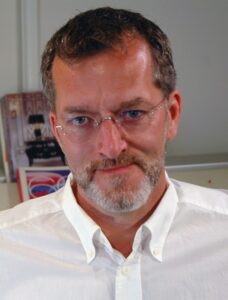
Below the Line: Was WandaVision your first project with Marvel? How did you get involved with it?
Mark Worthington: Well, two years ago, right about now, literally, I think even this week two years ago, Matt Shakman, the director, called me. Matt and I are old friends. We actually met on Ugly Betty, he was directing. I subsequently had done some theater with him, I’ve done a couple of pilots, if memory serves. We’ve worked together on multiple projects, so he came to me and said, “Hey, I’ve got this thing at Marvel.” I’ve not worked with them. I’m not necessarily such a Marvel guy, or wasn’t at that time — I am now. I was like, “Okay.” Then he described it to me and said, “Wow, that is very different from what my assumption of a Marvel project is.” I was fascinated. It’s such a great story and a great character piece. It just was unique, so I was hooked. I always want to work with Matt anyway, so that was a no-brainer. So that’s how I got involved.
BTL: How many hours of old TV did you watch and study when you found out about this. It must have been a lot.
Worthington: Yes, many, many hours of watching ’50s sitcoms, ’60s sitcoms — all those decades, just to get it right, and then diving into a lot of visual references and trying to find stills and behind the scenes. “And how did they do that? And how did that work?” So, that you’re not only looking at the finished product, but you’re trying to look at the mechanics of how they pulled it off. You probably know this, but we shot the first [episode] — the ’50s sitcom — in front of a live audience. So, we had to have the seating right, and all this lighting — that’s all the DP, who rented vintage lighting from Los Angeles and had it shipped in. That all looks correct, because of the one scene in Episode Eight, where she comes in, and she’s on the set and sees Agatha up in the seats, and so forth. All that had to look correct in terms of the period, so we did an immense amount of research, both in terms of looking at the shows themselves, and then trying to get as much research behind the scenes in the technical aspects as possible.
BTL: I haven’t spoken to Matt in a couple of years, but I wonder if he cast the audience for their ability to deliver a particular style of laughing.
Worthington: We invited people, some of them were people we knew, people on the show, that kind of stuff, but I don’t think you can curate an audience for [their] laughter. In all those shows, there was a warm-up and there is in every sitcom now. We went to do a bit of research at a three-camera show that summer when we came out here in L.A. just to see “What is this about?” Matt had been in sitcoms as a kid, so he knew, but they had warm-up acts, comics, would come and get the audience warmed up and ready to go, and then they tell them how to laugh. We didn’t really do that, but they literally sort of give you a primer in a three-camera show, like, “Here’s the sort of reactions we’re looking for. ” [laughs] And it works. People are into it — they come there to have the experience.
BTL: Obviously, the episodes set in the ‘50s, ‘60s and ‘70s were mostly one-set type shows, although we do go outside a little bit. How much change was there in between the different eras of that interior set while still keeping them consistent?
Worthington: It’s interesting, because we have both three-camera style shooting and we have single-camera style shooting. ’50s was three-camera, ’60s was single camera, ’70s was effectively single camera, ’80s was three-camera again. Some of the sets … it’s not like we came into the ’50s set and just repainted it and stuck new furniture in. That set actually went away, because it wasn’t quite physically what it needed to be for the other stuff. The steps that we did that with were actually the single-camera sets for ’60s and not even the ’70s. We repurposed some stuff, and we didn’t repurpose other things, but what remained consistent was the basic arrangement of elements. The front door is always in the same place. The staircase when it appears in the second episode in the ’60s is always in the same place. The kitchen’s in the same place, dining room and so on. What we understand — and I think it’s pretty clear — is that Wanda is iterating these sitcoms obviously in response to what’s going on, which is, she can’t absolutely keep control of the world that she’s created. Every time she hits a weird moment or a crisis moment or something happens, it iterates and now we’re in the ’80s. That’s not slavishly the case for every change, but that was kind of the idea. So, it was important that we see that it’s the same space, basically.
BTL: How was that for shooting if you have to finish one episode before redressing it for the next one. I’m not sure how the town square worked once that was introduced.
Worthington: The exterior town square was hard, because initially, we would have planned to go to the Universal backlot — the Back to the Future square, essentially — and it didn’t work out with timing. Also, COVID affected it with Universal, so we couldn’t make the deal, so we ended up at the Disney ranch for that. Part of the original deal was that maybe we’ll be on the backlot at Universal and then down the street, we’re at Blondie Street [at Warner Bros. Studios] — and we were there for the neighborhood. It would have been easy, maybe, to go, “Maybe we’ll go over there and shoot something and allow you guys to change it over.” But we didn’t have that luxury because they’re so distant. So, we were at Blondie, and then we were at Disney ranch. We had literally overnight changeovers for the [different] periods, which was very challenging. [chuckles] So, we had to make all the signage, it was plug and play, like “Pull that sign off, stick the sign on, do this, do that,” stuff in the window, and it was decorating and all that. That was one of the bigger logistical challenges of a show that had many logistical challenges.
BTL: I spoke to a couple visual FX people about the show, because I was really interested in how that town square was changed between the real world and Wanda’s world. I assume it was complicated.
Worthington: It is very complicated. There were some but not too many visual effects set extensions, actually. We tried to keep those to a minimum, because we wanted the visual effects resources to go to things like the final battle, where you really need it, as opposed to, “Oh, we don’t have the whole half of this street. Can you just put something in there?” I mean, they added water towers and got rid of mountains and things like that, but basically, what you see on the street level was all practical. We tried to keep as much of that [as possible]. It was a bit of a Swiss watch. Everything had to fit together just so in order for it to come off, just to be able to shoot, but we pulled it off. It wasn’t easy, but I think the result is pretty fun.
BTL: Did you shoot some stuff in the square before production was shut down due to COVID and then went back to shoot more stuff afterward?
Worthington: No, basically, we shot all the sitcoms, and we shot the pop-up Marvel base outside of town. A number of the locations like the SWORD headquarters, all of that stuff was Atlanta in set locations, and then we came out to LA and at the end of February, first part of March, and we were here for about two weeks prepping for the L.A. shoot here in those backlots. And then we had to shut down because of COVID, and then we came back up in late August and then prepped for a bit and shot.
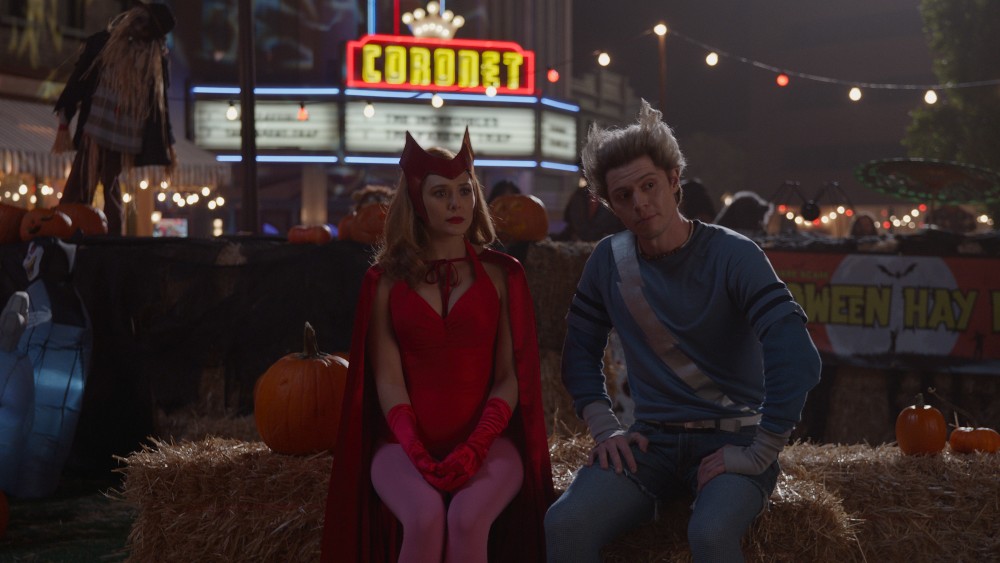
BTL: Was everything that you set up in March still there?
Worthington: Well, we hadn’t really done anything. We built a few things and they were in storage, but we had not physically affected any of the backlots, which was a good thing. We hadn’t gone in and started painting or doing anything like that. They were still there, and we went in, and it was a bit of a scramble to get it all together, but obviously, the studio wanted us to try to get it done as quickly as possible to reduce the prep time. But as it affected every show, COVID made everything more expensive. When we all got together and pulled ourselves by the bootstraps, we got it all done.
BTL: Was there construction that had been done or did you have to do that as well?
Worthington: We had to do all the construction, except for a big portion of the gazebo. The square had actually been built. We did that and then nothing else had been done. It was all done in August, basically everything else, prepping the streets. That was all done in that very short prep time we had.
BTL: We just ran a column about the differences working in television vs. film when you work in crafts. You’ve dabbled in film but you really seem to be more of a TV guy.
Worthington: Welllllll… I might dispute that a little bit, but yeah. If you go way, way back… I mean, as a designer, yes, I’ve been more TV but as an art director, I was in feature film for over 10 years. The first thing I art-directed was Tombstone.
BTL: I still want to ask the same question, though. What led to the decision to move forward and work more in one medium than the other?
Worthington: I’m sure you hear this from everybody in all walks of life in the film industry is that part of it is the opportunities that are afforded you. So, I was looking for features, I was looking to move up. I did some smaller features, actually, and did no TV, and then in 2004, I guess it was, a friend recommended me to JJ Abrams to do the pilot for Lost. So, that was my first foray into TV, which I’ve sort of been in that place with TV, more or less. I’ve always been mostly on these shows that are kind of breaking the mold and doing something new. Last obviously did that. Betty in a smaller way. It was still an episodic broadcast, obviously, but it was completely unusual for that particular part of TV when it came out. I think it should have come out on cable, but there it was. And on Horror Story the same thing, The Umbrella Academy, Watchmen in its own way, certainly WandaVision is doing a new thing, too. And then you’re in that stream and people look at you and it’s like, “Well, can you do features?” which I kind of chuckle at because there’s a lot of features that are much smaller than the stuff I’ve been doing for the last 10 years. Yeah, I think I can handle your feature film AND I’m actually just going onto a feature film now, interestingly, for the first time in a long time.
And also, frankly, TV or streaming or whatever we’re going to call it — because I think television is a term that is now broken, it’s too small to contain what we’re doing — the narrative possibilities in longer format, storytelling that we have in streaming — in premium, cable TV, wherever you want to call it — are really interesting. They are not always successful, and there’s a lot of stuff that is not great, in a way, but there’s a lot of stuff that’s just really groundbreaking and really interesting to be a part of.
WandaVision is an example. I mean, what is that exactly? It’s not really an episodic. It’s sort of an episodic format, but it’s playing with the episodic format in almost a META way to tell that story, and it’s really this bigger arc. So what is that? I love what I’ve been doing for the last many years, because it provides those opportunities. It always had its logistical challenges and stresses and all that kind of thing, especially because I think there’s a sensibility that television, in terms of the budgets, is that it’s still a form that is meant to be cheaper… and that’s changing too, because of what we see in the quality of the work. Anyway, I’m now going to go off and do a feature now, so I’m interested in doing both. It’s really project-dependent. If it’s an interesting project, I will look at it and want to do it. I just want to do something different, usually. That’s my goal.
BTL: If you talk to people about where things changed from television becoming as respected or better than movies, many would cite the pilot for Lost, or HBO’s The Sopranos, which was maybe five years earlier.
Worthington: They do a similar thing in breaking the mold in very different ways themselves. Lost starts as a two-hour action movie. That was the pilot, and then it turns into this wild mystery sci-fi spiritual… I mean, what is it exactly? How would you define that genre? Just the boldness of what JJ and Damon [Lindelof] did with that is astounding. That’s the kind of stuff that’s just like catnip for me as a designer, because anything that gives me the opportunity to do something different. I mean, five years of Horror Story was like a career’s worth of design. It was amazing, incredible, not easy, but Ryan is incredible, I mean, unique, just as a collaborator and a visionary with those things. To be there at that moment with him, when we were sort of inventing that thing, to be there, to be that guy, almost nobody gets that chance, so that was incredible.
BTL: Another interesting thing about WandaVision is that you worked with Matt as the sole director on the whole thing. We’re seeing that more and more now where a single director will do eight to ten episodes of television. On Horror Story, you probably worked with a dozen or more directors, so do you have a preference?
Worthington:I guess if I had to state a preference, I prefer to work with one person, because I think you build a vocabulary, and a shorthand that is really valuable, and it makes it more efficient. But also, it feels like a totality, like a single object, a single narrative, which I think WandaVision does. Horror Story has that to an extent, but because we are dealing with different directors and their tonal shifts, subtle but they’re there. I mean, Ryan’s pretty strict about keeping it within a certain wheelhouse, but he does like to give directors some latitude to try out new things and do things. They’re both interesting, and they’re both really valid. When you’re in a show like Horror Story, the creative leader is Ryan. If I have a fundamental creative question, frankly, I’m not going to go to the episodic director, I’m going to go to the showrunner Ryan, and say, “Hey, this is a completely new thing we’re doing here with a new character or a new story, whatever it is we’re encountering in the episode. How do you want to handle this? What are we doing?” The director will be there, but that world is a very different dynamic, because the creative force and the final say is the showrunner.
All episodes of WandaVision can be watched streaming on Disney+. All photos are courtesy of Marvel Studios and Disney, except where noted. Also, check out Neil Turitz’s latest “The Accidental Turitz” column where he talks about Marvel’s Emmy chances with shows like WandaVision.

